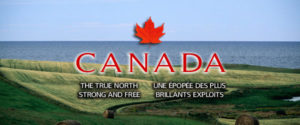
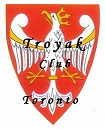
TROYAK EXECUTIVE TEAM is informing all members, colleagues, collectors and Polonia at large, that Club meetings taking place at John Paul II Polish Cultural Centre, 4300 Cawthra Rd. (just south of Hwy. 403), Mississauga, Ontario. The new members are always welcome. www.polishculturalcentre.ca
ADRES SPOTKAÑ KLUBOWYCH ! Zarząd Główny Klubu “Troyak” informuje wszystkich członków kolekcjonerów, sympatyków oraz całą Polonię, że spotkania klubowe odbywają się w Polskim Centrum Kultury im. Jana Pawła II, przy 4300 Cawthra Rd. (na południe od autostrady 403), Mississauga, Ontario. Zapraszamy nowych członków do prężnego. Klubu “Troyak”. www.polishculturalcentre.ca

“TROYAK” CLUB NEXT MEETINGS …
NASTĘPNE SPOTKANIA KLUBU “TROYAK” …
6th October 2019 @ 9:00 a.m. to 4:00 p.m. …
Mississauga’s Coin & Stamp Show 2019

27th October 2019 @ 4:30 p.m.
24th November 2019
December 2019 @ Happy Holidays !
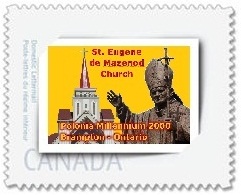

12th January 2020 @ 4:30 p.m. … Annual General Meeting
26th January 2020; 23rd February 2020

8th March 2020 …
XVII Polish – Canadian Coin, Stamp & Collectibles Show 2020

29th March 2020 @ 4:30 p.m.
26th April 2020; 31st May 2020; 21st June 2020
July & August 2020 – Summer break … Letnie wakacje …

100. Rocznica utworzenia Centralnej Biblioteki Wojskowej
100th Anniversary of the Establishment of the Central
Military Library
www.poczta-polska.pl
Dnia 13 czerwca 2019 r. została wprowadzona do obiegu kartka pocztowa z nadrukowanym znakiem opłaty pocztowej, emisji: 100.rocznica utworzenia Centralnej Biblioteki Wojskowej. Wartość nominalna znaku opłaty pocztowej z oznaczeniem literowym A odpowiada wartości nominalnej znaczka pocztowego używanego do uiszczenia opłaty za ekonomiczną przesyłkę listową nierejestrowaną, w tym kartkę pocztową, w obrocie krajowym, w formacie S o masie do 500 g. W prawym górnym rogu strony adresowej kartki nadrukowano znak opłaty pocztowej, na którym widnieje fotografia przedstawiająca pierwszego dyrektora Centralnej Biblioteki Wojskowej, ppłk dr Mariana Łodyńskiego; wzdłuż lewej krawędzi znaczka umieszczono napis ,,Polska”; a w prawym górnym rogu oznaczenie wartości A. W części ilustracyjnej kartki znajduje się nazwa emisji ,,100. rocznica utworzenia Centralnej Biblioteki Wojskowej” oraz zdjęcie wnętrza obecnej czytelni Centralnej Biblioteki Wojskowej. Kartkę o wymiarach 148 x 105 mm wydrukowano jednostronnie, techniką offsetową, na kartonie białym, w nakładzie 8000 sztuk. Autor projektu: Andrzej Gosik.
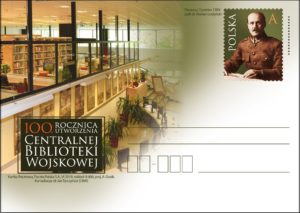
100th Anniversary of the Establishment of the Central Military
Library… denomination: 3,30 PLN; number of stationeries in set: 1;
print run: 8.000 pcs; printing technique: offset; card size: 148 x 105 mm;
author: Andrzej Gosik; release date: 13th June 2019.

Błogosławionych 108 męczenników polskich
108 Blessed Polish Martyrs
www.poczta-polska.pl
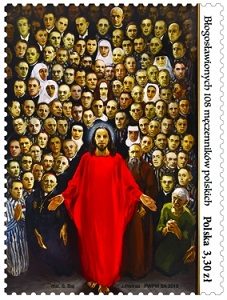
W dniu 15 czerwca 2019 r. został wprowadzony do obiegu znaczek pocztowy o wartości 3,30 zł emisji “Błogosławionych 108 męczenników polskich”. Na znaczku przedstawiono obraz beatyfikacyjny 108 męczenników polskich II wojny światowej, autorstwa Stanisława Baja, znajdujący się obecnie w kaplicy Sanktuarium Maryjnego w Licheniu. Znaczek wydrukowano techniką rotograwiurową, na papierze fluorescencyjnym, format znaczka: 40,5 x 54 mm, w nakładzie 140.000 szt. Arkusz sprzedażny zawiera 35 szt. znaczków. Z tej okazji została wydana również koperta FDC. Autor projektu: Jerzy Pietras. Autor obrazu: Stanisław Baj.
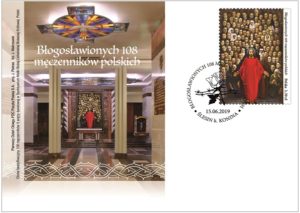
108 Blessed Polish Martyrs … denomination: 3,30 PLN;
number of stamps in set: 1 (35 pcs in sheet);
print run: 140.000 pcs.; printing techniques: photogravure;
paper: fluorescent; stamp size: 40,5 x 54 mm;
number of FDC: 1; author of the project: Jerzy Pietras;
author of the painting: Stanisław Baj; circulation date: 15th June 2019.

Tydzień Kultury Beskidzkiej
Beskid Culture Week
www.poczta-polska.pl
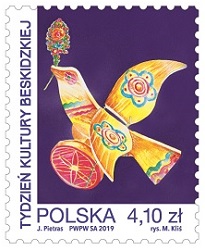
W dniu 19 czerwca 2019 r. został wprowadzony do obiegu znaczek pocztowy o wartości 4,10 zł emisji “Tydzień Kultury Beskidzkiej”. Na znaczku przedstawiono wizerunek klepoka – drewnianego ptaszka, symbol Tygodnia Kultury Beskidzkiej, namalowany przez prof. Michała Klisia. Znaczek wydrukowano techniką rotograwiurową, na papierze fluorescencyjnym, w formacie 25,5 x 31,25 mm, w wielomilionowym, powtarzalnym nakładzie. Arkusz sprzedażny zawiera 100 szt. znaczków. Z tej okazji została wydana również koperta FDC. Autor projektu: Jerzy Pietras. Autor obrazu: Michał Kliś.
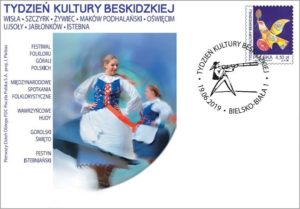
Beskid Culture Week … denomination: 4,10 PLN;
number of stamps in set: 1 (100 pcs in sheet);
print run: millions pcs.; printing techniques: photogravure;
paper: fluorescent; stamp size: 25,5 x 31,25 mm;
number of FDC: 1; author of the project: Jerzy Pietras;
author of the painting: Michał Kliś; circulation date: 19th June 2019.

Zabytkowe organy w Polsce
Historic Organs in Poland
www.poczta-polska.pl
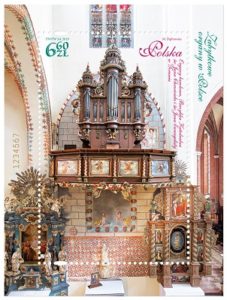
W dniu 21 czerwca 2019 r. został wprowadzony do obiegu znaczek pocztowy o wartości 6,60 zł emisji “Zabytkowe organy w Polsce”. Na znaczku przedstawiono organy barokowe z Bazyliki Katedralnej św. Jana Chrzciciela i św. Jana Ewangelisty w Toruniu. Znaczek wydrukowano techniką offsetową, na papierze fluorescencyjnym, w formacie: 51 x 79 mm, w bloku numerowanym formatu 75 x 100 mm, w nakładzie 100 000 sztuk. Z tej okazji została wydana również koperta FDC. Autorka projektu: Marzanna Dąbrowska.
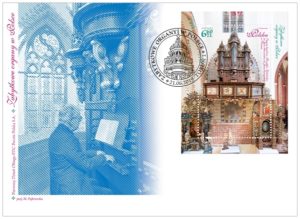
Historic Organs in Poland … denomination: 6,60 PLN;
number of stamps in set: 1 in a form of a block; print run: 100.000 pcs.;
printing techniques: offset; paper: fluorescent; stamp size: 51 x 79 mm;
block size: 75 x 100 mm; number of FDC: 1;
author: Marzanna Dąbrowska; circulation date: 21st June 2019.

Anna Walentynowicz
www.poczta-polska.pl
W dniu 24 czerwca 2019 r. został wprowadzony do obiegu znaczek pocztowy o wartości 8,70 zł emisji “Anna Walentynowicz”. Na znaczku przedstawiono portret Anny Walentynowicz na tle portowych dźwigów. Znaczek wydrukowano techniką rotograwiurową, na papierze fluorescencyjnym, w formacie 25,5 x 31,25 mm, w wielomilionowym nakładzie. Arkusz sprzedażny zawiera 100 szt. znaczków. Z tej okazji została wydana również koperta FDC. Autor projektu: Maciej Jędrysik.
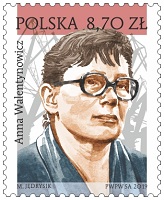
Anna Walentynowicz … denomination: 8,70 PLN;
number of stamps in set: 1 (100 pcs in sheet);
print run: milions pcs.; printing techniques: photogravure;
paper: fluorescent; stamp size: 25,5 x 31,25 mm
number of FDC: 1; author: Maciej Jędrysik;
circulation date: 24th June 2019.
Portret Anny Walentynowicz widnieje na najnowszym znaczku Poczty Polskiej, który trafił do obiegu 24 czerwca br. Uroczysta prezentacja znaczka odbyła się w Stoczni Gdańskiej w historycznej Sali BHP z udziałem rodziny dawnej opozycjonistki oraz przedstawicieli rządu, IPN-u i Poczty Polskiej. Rok 2019 – zgodnie z decyzją Sejmu – to rok Anny Walentynowicz. Znaczek obiegowy z wizerunkiem Anny Walentynowicz przedstawionej na tle stoczniowych dźwigów został wprowadzony do obiegu w nakładzie 1 mln sztuk. Jego autorem jest Maciej Jędrysik.
– Dzisiaj Poczta Polska wprowadza do obiegu znaczek z wizerunkiem Anny Walentynowicz. To wyraz uznania dla tej wybitnej postaci. Nazwisko Anny Walentynowicz ma swoje godne miejsce w historii polskiego ruchu robotniczego i w historii Polski. Emitując ten znaczek Poczta Polska wypełnia niezwykle ważną misję edukacyjną – mówi minister infrastruktury Andrzej Adamczyk.
We wrześniu 1980 r. Anna Walentynowicz została członkiem Prezydium Międzyzakładowego Komitetu Założycielskiego Niezależnego Samorządnego Związku Zawodowego w Gdańsku. Była jedną z najpopularniejszych postaci „Solidarności”. Po wprowadzeniu stanu wojennego w grudniu 1981 r. została internowana w Fordonie, a następnie w Gołdapi. W 1981 r. Służba Bezpieczeństwa próbowała ją otruć. Po wypuszczeniu na wolność współorganizowała głodówki, uczestniczyła w licznych spotkaniach w kościołach, pisała osobiste protesty i oświadczenia skierowane do władzy. W okresie PRL była wielokrotnie nękana przez komunistów.
– Nie ulega wątpliwości, że to jedna z najważniejszych postaci w najnowszej historii Polski. Odegrała kluczową rolę w latach 80 i 90. Kiedy na początku sierpnia 1980 r., na pięć miesięcy przed odejściem na emeryturę, rozwiązano z nią umowę o pracę, robotnicy Stoczni Gdańskiej zażądali natychmiastowego przywrócenia jej do grona zatrudnionych. Właśnie to żądanie stało się pierwszym postulatem strajku, który rozpoczął się 14 sierpnia w Stoczni Gdańskiej – mówi Przemysław Sypniewski, prezes zarządu Poczty Polskiej.
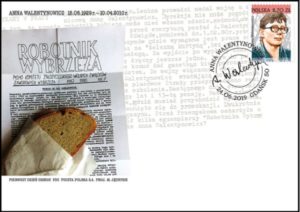
Za swoją działalność Anna Walentynowicz została odznaczona w maju 2006 r. przez prezydenta RP Lecha Kaczyńskiego Orderem Orła Białego. Zginęła w katastrofie samolotu prezydenckiego 10 kwietnia 2010 r. pod Smoleńskiem.
– Poczta Polska upamiętnia na znaczkach i kartkach pocztowych najważniejszych Polaków. Anna Walentynowicz należy do tego grona. Ta skromna, ale też niezwykle silna kobieta powinna być wzorem do naśladowania dla współczesnych. Bez niej nie byłoby wolnej i niepodległej Rzeczpospolitej. Winni jesteśmy oddawać jej należny hołd – podkreśla Przemysław Sypniewski.
Oprócz okolicznościowego znaczka Poczta Polska wydała, w limitowanej wersji, kopertę FDC, czyli kopertę wydawaną w pierwszym dniu obiegu znaczków. Widnieje na niej wizerunek Anny Walentynowicz oraz grafika przedstawiająca jeden z numerów „Robotnika Wybrzeża”, pisma Komitetu Założycielskiego Wolnych Związków Zawodowych Wybrzeża z ułożoną na wierzchu kromką chleba. Periodyk wydawany był nieregularnie od sierpnia 1978 do maja 1980 roku. Walentynowicz wchodziła w skład redakcyjny tej gazety.

Objawienia Matki Bożej w Gietrzwałdzie
Revelations of Our Lady in Gietrzwald
www.poczta-polska.pl
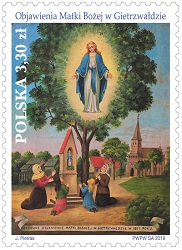
W dniu 27 czerwca 2019 r. został wprowadzony do obiegu znaczek pocztowy o wartości 3,30 zł emisji “Objawienia Matki Bożej w Gietrzwałdzie”. Na znaczku przedstawiono obraz ilustrujący objawienie Matki Bożej w Gietrzwałdzie w 1877 roku, znajdujący się obecnie w Sanktuarium Maryjnym w Gietrzwałdzie – obraz przedstawia modlące się przed Kapliczką Objawień dwie małe dziewczynki, wizjonerki: Barbarę Samulowską i Justynę Szafryńską i towarzyszące im w modlitwie matki. Znaczek wydrukowano techniką rotograwiurową, na papierze fluorescencyjnym, w formacie 31,25 x 43 mm, w nakładzie 180 000 sztuk. Arkusz sprzedażny zawiera 9 szt. znaczków. Z tej okazji została wydana również koperta FDC. Autor projektu: Jerzy Pietras.
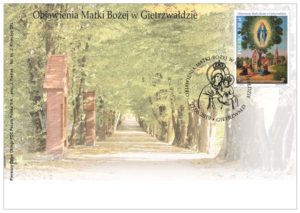
Revelations of Our Lady in Gietrzwald … denomination: 3,30 PLN;
number of stamps in set: 1 (9 pcs in sheet); print run: 180 000 pcs.
printing techniques: photogravure; paper: fluorescent;
stamp size: 31,25 x 43 mm; number of FDC: 1;
author: Jerzy Pietras; circulation date: 27th June 2019.

450. rocznica Unii Lubelskiej
450 years of Union of Lublin
www.poczta-polska.pl
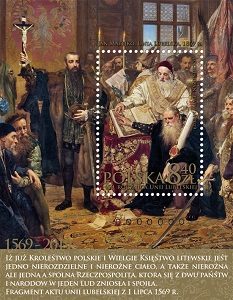
W dniu 01 lipca 2019 r. został wprowadzony do obiegu znaczek pocztowy o wartości 8,40 zł emisji “450. rocznica Unii Lubelskiej”. Na znaczku przedstawiono fragment obrazu Jana Matejki, z 1869 roku – Unia Lubelska; wzdłuż dolnej krawędzi umieszczono temat emisji: 450.ROCZNICA UNII LUBELSKIEJ, napis POLSKA oraz oznaczenie wartości 8,40 zł. Na oprawie bloku umieszczono tekst: ,,IŻ JUŻ KROLEŚTWO POLSKIE I WIELGIE KSIĘŚTWO LITEWSKIE JEŚT JEDNO NIEROZDZIELNE I NIEROŻNE CIAŁO, A TAKŻE NIEROŻNA ALE JEDNA A SPOLNA RZECZPOSPOLITA, KTORA SIĘ Z DWU PAŃŚTW I NARODOW W JEDEN LUD ZNIOSŁA I SPOIŁA. FRAGMENT AKTU UNII LUBELSKIEJ Z 1 LIPCA 1569 R.” a nad nim lata: 1569 – 2019. Znaczek wydrukowano techniką rotograwiurową, na papierze fluorescencyjnym, w formacie: 31,25 x 43 mm, w bloku formatu 70 x 90 mm, w nakładzie 100 000 sztuk. Z tej okazji została wydana również koperta FDC. Autor projektu: Jarosław Ochendzan.
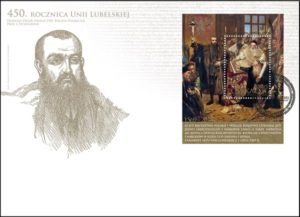
450 years of Union of Lublin … denomination: 8,40 PLN;
number of stamps in set: 1 in a form of a block;
print run: 100.000 pcs.; printing techniques: photogravure;
paper: fluorescent; stamp size: 31,25 x 43 mm;
block size: 70 x 90 mm; number of FDC: 1;
author: Jarosław Ochendzan; circulation date: 1st July 2019.

Historia Monety Polskiej – szóstak Jana Sobieskiego
www.nbp.pl
Narodowy Bank Polski jest centralnym bankiem państwa odpowiadającym za politykę pieniężną i stabilność cen. Jego funkcje określa Konstytucja Rzeczypospolitej Polskiej i ustawa o NBP. NBP ma wyłączne prawo emisji pieniądza. Jako bank centralny nie prowadzi rachunków bankowych obywateli, nie przyjmuje od nich lokat, nie udziela kredytów. Prowadzi natomiast obsługę budżetu państwa, a także podmiotów sektora finansów publicznych. Gromadzi rezerwy walutowe państwa i zarządza nimi. Pełni funkcję banku banków, tworząc warunki do działania systemu bankowego. Jest również jednym z najważniejszych ośrodków naukowo- -analitycznych w dziedzinie ekonomii i rynków finansowych. 10 lipca 2019 roku Narodowy Bank Polski wprowadził do obiegu srebrną monetę o nominale 20 zł „Historia monety polskiej” – szóstak Jana Sobieskiego.
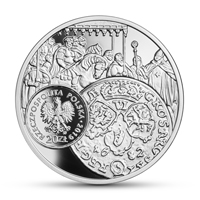
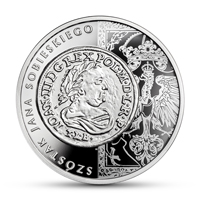
Nominał 20 zł … metal: Ag 925/1000; stempel: lustrzany;
średnica: 38,61 mm; masa: 28,28 g; brzeg (bok): gładki;
nakład: do 13 000 szt.; Projektant monety: Dominika Karpińska-Kopiec;
Emitent: NBP; Na zlecenie NBP monetę wyprodukowała
Mennica Polska S.A.
Działalność mennicza za panowania Jana III Sobieskiego (1674−1696) była ograniczona w czasie. Mennicę bydgoską uruchomiono bowiem dopiero w 1677 r., a krakowską w 1679. Zamknięcie obu mennic nastąpiło natomiast już w 1685 r. Wynika z tego, że w czasie ponaddwudziestoletniego panowania król wybijał monety jedynie przez osiem lat. Były to przede wszystkim srebrne monety koronne: trojaki, szóstaki i orty (18 groszy) oraz niewielka ilość monet złotych. Najpowszechniejszą monetą był szóstak. Na awersie nosi on antykizujące popiersie króla w todze i wieńcu laurowym. Otacza je legenda: IOAN[nes].III. D[ei].G[ratia] REX POL[oniae] M[agnus]. D[ux].L[ituaniae].R[ussiae]. P[russiae], co znaczy: „Jan III z Bożej łaski król Polski, wielki książę litewski, ruski, pruski”. Pod popiersiem inicjały Tytusa Liwiusza Boratiniego – T.L.B., dzierżawcy obu mennic. Na rewersie umieszczono pod koroną cyfrę VI i trzy tarcze z herbami Polski, Litwy i Janiny (Sobieskich).
W otoku napis: GROS[si].ARG[entei].SEX– REG[ni].POLONIAE, czyli „Groszy srebrnych sześć Królestwa Polskiego”. W połowie napisu herb Leliwa Jana Andrzeja Morsztyna, podskarbiego wielkiego koronnego. Na dole data 16 – 82 rozdzielona tarczą Sobieskich. Zrozumiałe jest, że wizerunek tej monety, reprezentatywnej dla mennictwa króla, znalazł się na nowej monecie NBP. Na jej stronie głównej umieszczono rewers szóstaka i tradycyjną już, okrągłą tarczkę z napisem: Rzeczpospolita Polska, wizerunkiem orła ustalonym dla godła Rzeczypospolitej Polskiej, nominałem 20 ZŁ i rokiem emisji: 2019; powyżej fragment płaskorzeźby z pałacu w Wilanowie przedstawiającej Jana Sobieskiego na koniu tuż przed koronacją królewską. Na stronie odwrotnej monety widać awers szóstaka, a z prawej strony Orła z herbem Janina na piersiach z herbarza Wacława Potockiego z 1696 r. Całości dopełnia napis z lewej strony: SZÓSTAK JANA SOBIESKIEGO. Informacja: Stanisław Suchodolski.

History of Polish Coin
– the szóstak (six grosz) of John III Sobieski
www.nbp.pl
Narodowy Bank Polski is the central bank of the State, responsible for its monetary policy and price stability. The Bank’s functions are described in the Constitution of the Republic of Poland and the Act on NBP. NBP holds the exclusive right to issue the currency of the Republic of Poland. As the central bank, it does not provide accounts for the general public, accept deposits from or extend loans to individuals. It acts as a banker to the State budget and public sector entities. NBP also holds and manages the foreign exchange reserves of the State. Finally, it functions as a banker to banks, creating conditions for the operation of the Polish banking system. Narodowy Bank Polski is one of the most important research and analytical centres in the fields of economics and financial markets. On 10 July 2019, Narodowy Bank Polski issued into circulation a silver coin of the series “History of Polish Coin” – The Szóstak (six grosz) of John III Sobieski, with a face value of 20 zł.


Face value 20 zł … Metal: Ag 925/1000; Finish: proof;
Diameter: 38.61 mm; Weight: 28.28 g; Edge: plain;
Mintage: up to 13,000 pcs; Coin designer: Dominika Karpińska-Kopiec;
Issuer: NBP; The coins, commissioned by NBP, were struck by
Mennica Polska S.A.
Minting activity during the reign of John III Sobieski (1674−1696) lasted for a short period of time. The mint of Bydgoszcz became operational only in 1677 and the mint in Kraków – in 1679, but they were shut down as early as in 1685. This implies that during the almost two decadxe-long reign, coins were struck for only 8 years. These were mostly silver crown coins: the trojak (three grosz), szóstak (six grosz) and ort (18 grosz) coins, and a small amount of gold coins. The szóstak was the most popular one. The obverse of the coin features the bust of the King in ancient style, wearing a toga and a laurel wreath. The bust is surrounded by the legend: IOAN[nes] III. D[ei].G[ratia] REX POL[oniae] M[agnus]. D[ux].L[ituaniae].R[ussiae].P[russiae], which means ”John III, by the Grace of God, King of Poland, Grand Duke of Lithuania, Ruthenia and Prussia.” Below the bust, there are the initials T.L.B. of Titus Livius Boratini, the lessee of the two mints.
The reverse shows, below the crown, a Roman numeral, VI, and three escutcheons with the coats-of-arms of Poland, Lithuania and Janina (of the Sobieskis). Along the rim, there is an inscription: GROS[si]. ARG[entei].SEX – REG[ni].POLONIAE, i.e. “The silver six grosz coin of the Kingdom of Poland”. In the middle of the inscription, there is the coatof-arms Leliwa of Jan Andrzej Morsztyn, the Grand Treasurer of the Crown. At the bottom, the date 16–82 divided by the escutcheon of the Sobieskis. It is obvious that the image of this coin, which was representative for the minting activity of the King, should be shown on a new coin of NBP.
The main side of the new coin depicts the reverse of the szóstak and, traditionally, a small round stamp with an inscription: Rzeczpospolita Polska (Republic of Poland), the image of the Eagle established as the emblem of the Republic of Poland, the face value of 20 ZŁ and the year of issue: 2019. Above the bust, there is a fragment of the bas-relief from Wilanów Palace showing John Sobieski on horseback shortly before the royal coronation. On the reverse side of the coin you can see the obverse of the six-grosz coin, and on its right side there is the Eagle bearing on its breast the Janina coat-ofarms from the armorial of Wacław Potocki of 1696. An inscription on the left side: SZÓSTAK JANA SOBIESKIEGO (six grosz coin of John Sobieski) completes the design. Info: Stanisław Suchodolski.

75th Rocznica zagłady Romów i Sinti
www.nbp.pl
Narodowy Bank Polski jest centralnym bankiem państwa odpowiadającym za politykę pieniężną i stabilność cen. Jego funkcje określa Konstytucja Rzeczypospolitej Polskiej i ustawa o NBP. NBP ma wyłączne prawo emisji pieniądza. Jako bank centralny nie prowadzi rachunków bankowych obywateli, nie przyjmuje od nich lokat, nie udziela kredytów. Prowadzi natomiast obsługę budżetu państwa, a także podmiotów sektora finansów publicznych. Gromadzi rezerwy walutowe państwa i zarządza nimi. Pełni funkcję banku banków, tworząc warunki do działania systemu bankowego. Jest również jednym z najważniejszych ośrodków naukowo-analitycznych w dziedzinie ekonomii i rynków finansowych. 24 lipca 2019 roku Narodowy Bank Polski wprowadził do obiegu srebrną monetę o nominale 10 zł „75. rocznica zagłady Romów i Sinti”.
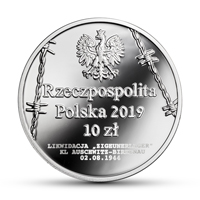
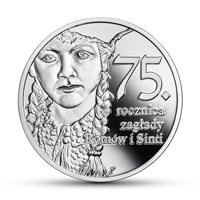
Nominał 10 zł … metal: Ag 925/1000; stempel: lustrzany;
średnica: 32,00 mm; masa: 14,14 g; brzeg (bok): gładki;
nakład: do 13 000 szt.; Projektant: Urszula Walerzak; Emitent: NBP;
Na zlecenie NBP monety wyprodukowała Mennica Polska S.A.
Druga wojna światowa była w dziejach Romów tragicznym okresem, w którym niemieccy naziści i ich sojusznicy dokonali na nich − podobnie jak na Żydach − zbrodni ludobójstwa. Była to próba zagłady całego narodu z przyczyn rasowych. Eksterminacja była realizowana przez III Rzeszę w sposób planowy w latach 1943–1944 zgodnie z dekretem Heinricha Himmlera z grudnia 1942 r. w sprawie „ostatecznego rozwiązania problemu cygańskiego”. Zbiorowe egzekucje miały miejsce również wcześniej, co wiązało się z wkraczaniem niemieckich wojsk okupacyjnych na podbite tereny.
Przyjmuje się, że w tym czasie w Europie zamordowano około 500 tysięcy Romów, czyli prawdopodobnie około 50% ich przedwojennej populacji. Odgórnie zaplanowane działania były prowadzone w różnych miejscach – między innymi w obozach masowej zagłady. W KL Auschwitz II – Birkenau funkcjonował w latach 1943–1944 romski obóz rodzinny („Zigeunerlager”). W sumie przez obóz przewinęło się ponad 23 tysiące Romów i Sinti pochodzących z różnych krajów europejskich. W nocy z 2 na 3 sierpnia 1944 r. obóz romski zlikwidowano, a więźniów zamordowano w komorach gazowych. Na terenie byłego KL Auschwitz II – Birkenau, w miejscu, gdzie był obóz romski, znajduje się pomnik poświęcony zagładzie europejskich Romów.
Od ponad ćwierć wieku, co roku 2 sierpnia odbywają się tu światowe uroczystości upamiętniające tę tragedię. W 1996 r. na międzynarodowej konferencji zorganizowanej w Oświęcimiu liderzy romscy z 10 krajów europejskich oraz ze Stanów Zjednoczonych ustanowili 2 sierpnia Międzynarodowym Dniem Pamięci o Zagładzie Romów. Wspomnienie dnia Zagłady Romów i Sinti jest także uroczyście celebrowane w Polsce na mocy uchwały Sejmu RP z 2011 r. Moneta upamiętnia tragiczne wydarzenia z nocy z 2 na 3 sierpnia 1944 r. Na rewersie monety umieszczono wizerunek ocalałej z zagłady Marianny Paczkowskiej (1925−2010), wykonany według zachowanej fotografii. W marcu 1944 r. została deportowana wraz z rodziną do „Zigeunerlager” w KL Auschwitz II – Birkenau (w rejestrze zapisana jako Paczkowski Marie, numer obozowy 10042). Jako osoba zdolna do pracy została przeniesiona do KL Ravensbrueck, a stamtąd do podobozu Wolkenburg. W nocy z 2 na 3 sierpnia 1944 r. jej rodzina została zamordowana w komorze gazowej. Na awersie monety został umieszczony napis: Likwidacja „Zigeunerlager” KL Auschwitz – Birkenau 02.08.1944 r. oraz wizerunki drutów kolczastych. Informacja: Tadeusz Czekaj.

75th Anniversary of the Romani and Sinti Genocide
www.nbp.pl
Narodowy Bank Polski is the central bank of the State, responsible for its monetary policy and price stability. The Bank’s functions are described in the Constitution of the Republic of Poland and the Act on NBP. NBP holds the exclusive right to issue the currency of the Republic of Poland. As the central bank, it does not provide accounts for the general public, accept deposits from or extend loans to individuals. It acts as a banker to the State budget and public sector entities. NBP also holds and manages the foreign exchange reserves of the State. Finally, it functions as a banker to banks, creating conditions for the operation of the Polish banking system. Narodowy Bank Polski is one of the most important research and analytical centres in the fields of economics and financial markets. On 24 July 2019, Narodowy Bank Polski issued into circulation a silver coin “75th Anniversary of the Romani and Sinti Genocide” with a face value of 10 złoty.


Face value: 10 zł … Metal: Ag 925/1000; Finish: proof;
Diameter: 32.00 mm; Weight: 14.14 g; Edge (side): plain;
Mintage: up to 13,000 pcs; Designer: Urszula Walerzak; Issuer: NBP;
The coins, commissioned by NBP, were struck by Mennica Polska S.A.
In the history of the Romani, the Second World War was a tragic period during which the German Nazis and their allies committed genocide on them – as they did with the Jews. This was a racially motivated attempt at exterminating the whole nation. The extermination was carried out in a systematic manner by the Third Reich between 1943–1944, according to the decree by Heinrich Himmler from December 1942 on the “final solution to the Gypsy question”. Mass executions had also taken place earlier, which was associated with the German occupation troops marching into the conquered territories. It is estimated that in this period in Europe some 500 thousand Romani were murdered, which probably accounted for about 50 per cent of their pre-war population. Operations based on a top-down plan were conducted in various places – in mass extermination camps, among others. The KL Auschwitz II – Birkenau concentration camp operated a Romani family camp (“Zigeunerlager”) in the years 1943–1944. More than 23 thousand Romani and Sinti from various European countries had been imprisoned in the camp.
On the night of 2 August 1944, the Romani camp was liquidated, and the prisoners were murdered in gas chambers. Today, at the former KL Auschwitz II – Brikenau, at the site of the Romani camp there is a statue in memory of the extermination of European Romani. For over a quarter of a century, every year on 2 August international events have been held here to commemorate this tragedy. In 1996, during an international conference organised in Oświęcin, Romani leaders from 10 European countries and the United Statesestablished the 2nd of August as the International Roma Genocide Remembrance Day. The Roma and Sinti Genocide Day celebrations are also observed in Poland, pursuant to a resolution of the Polish Sejm of 2011.
The coin commemorates the tragic events of the night of 2 August 1944. The reverse of the coin features an image of a survivor of the genocide, Marianna Paczkowska (1925–2010), modelled on a preserved photograph. She was deported with her family in March 1944 to “Zigeunerlager” at the KL Auschwitz II – Birkenau (she was registered as Paczkowski Marie, camp number 10042). Being able to work, she was transferred to the KL Ravensbrueck, and from there to the subcamp Wolkenburg. On the night of 2 August 1944, her family was murdered in a gas chamber. The obverse of the coin features the inscription: Likwidacja “Zigeunerlager” KL Auschwitz-Birkenau (Liquidation of Zigeunerlager KL Auschwitz-Birkenau) 02.08.1944 and images of barbed wire. Info: Tadeusz Czekaj.


Guglielmo Marconi (1874 – 1937)
www.canadapost.ca https://postagestampguide.com
In 1901 Guglielmo Marconi, the Italian physicist who developed the wireless telegraph in 1895, began planning his first transatlantic transmission. He chose St. John’s, Newfoundland as his receiving site. Other scientists, theorizing that the curvature of the earth would prevent transmission beyond 100 to 200 miles, predicted failure. Marconi, however, persisted in his experiment. In December of 1901 came his great triumph. At his receiver in Cabot’s Tower atop Signal Hill, Marconi received signals across the Atlantic Ocean sent from Cornwall. As he thought, electric waves followed the curvature of the earth. Marconi’s success caused an immediate sensation in every part of the civilized world. This event marked the beginning of the vast developments in electronic communications – radio, television, and radar – which would transform the world in the next hundred years. (46-X-19)
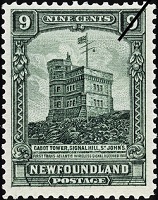
Denomination: 9¢ … Perforation or Dimension: 13.5 x 14, 14;
Date of Issue: January 3, 1928;
Printer: Thomas De La Rue & Company.
Postal Administration: Newfoundland.
Cabot Tower, Signal Hill, St. John’s First Trans-Atlantic Wireless Signal Received, 1901 … Based on a photograph by Robert Edward Holloway.
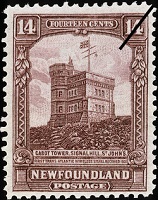
Denomination: 14¢ … Perforation or Dimension: 13 x 13.5, 14;
Date of Issue: August 23, 1928;
Printer: Thomas De La Rue & Company.
Postal Administration: Newfoundland.
Cabot Tower, Signal Hill, St. John’s First Trans-Atlantic Wireless Signal Received, 1901 … Based on a photograph by Robert Edward Holloway.
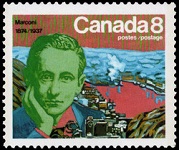
Denomination: 8¢ … Perforation or Dimension: 13.5 x 13;
Quantity: 31,185,000; Date of Issue: November 15, 1974;
Printer: Ashton-Potter Limited.
Marconi, 1874 – 1937 … About Stamp … As part of its multicultural series the Post Office will commemorate the centenary of the birth of Guglielmo Marconi, father of the radio. The stamp will recognize the contributions of all Italians to the development of Canada. Marconi was born at Bologna on April 25, 1874, the son of an Italian father and an Irish mother. Young Guglielmo’s educational career was not spectacular. He played hooky from his tutor and failed to qualify for both the Italian Naval Academy and the University of Bologna. However, he had always enjoyed dismantling things to see how they operated and at the Leghorn Technical Institute and in private lessons, he acquired a solid grounding in physics, chemistry and electricity. Marconi’s scientific progress was not helped by his father, who believing his son was wasting time, smashed every unhidden piece of the boy’s scientific equipment.
In 1894 Marconi read the obituary of Heinrich Hertz, an experimenter with electromagnetic waves. Marconi immediately decided that these waves could be adapted to carry telegraphic messages and that he would prove it. His only problem was that, in his own words “the idea was so elementary, so simple in logic, that it seemed difficult for me to believe that no one else had thought of putting it into practice”. Marconi worked from 1894 to 1896 with the methodical patience and determination typical of him and he increased the range of his signal to over a mile. After having been refused the support of the Italian government, Marconi moved to England where he was assisted and encouraged by William Preece, the Chief Engineer of the British Post Office. Progress was continuous, and in March 1899 the first message was beamed across the English Channel.
This success conjured up the dream of spanning the Atlantic. Marconi had problems convincing his backers to finance this project especially since many top-notch scientists suspected that radio waves, travelling in straight lines, would be blocked at the horizon. Marconi, however, was never dismayed by conventional scientific opinion and he felt that all he needed was a more powerful transmitter and a more sensitive receiver to get over the one hundred and fifty mile-high colossus of water between Europe and North America. He chose Poldhu in Cornwall for his transmitter and Cape Cod in Massachusetts for the receiver but when the elaborate aerials at both locations collapsed, he decided to make do with a weaker system. He compensated for this factor by moving the receiver to Newfoundland, the part of North America closest to Poldhu.
The inventor landed at St. John’s on December 6, 1901. The authorities allowed him to use some abandoned military buildings on Signal Hill overlooking the harbour. Nearby was a memorial to Giovanni Caboto, or John Cabot as he is better known, another Italian whose name is linked with Canada. By Wednesday, December 11, everything was in readiness and that afternoon Marconi sat down to listen for the prearranged signal, three dots of the Morse letter S. S had been chosen because dots used less energy than dashes, and it was believed they would be easier to pick out against the atmospheric background. Just before the wind tore free a balloon supporting the aerial, Marconi faintly heard a few of the S’s being generated 1700 miles away. The remainder of the stay in Newfoundland was inevitably anti-climatic.
Radio reception was always poor and even running an aerial from the west of Signal Hill to an iceberg grounded in the harbour didn’t help. When news of the great achievement reached reporters, it was hailed as “the most wonderful scientific discovery of modern times”, but a telegraph company which monopolized communications within Newfoundland was unimpressed and threatened to sue if the experiments did not cease. Marconi was just as glad because he wanted to avoid a public demonstration until he could improve reception. The stamp in honour of Guglielmo Marconi was designed by John B. Boyle. The painting in acrylics combines a portrait of Marconi with a view of St. John’s harbour from Signal Hill. Designed by Ken Rodmell. The hidden date for this stamp can be found in the bottom-right corner.
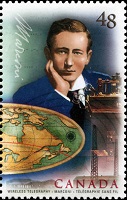
Denomination: 48¢ … Perforation or Dimension: 13 x 12.5;
Quantity: 2,500,000; Date of Issue: October 31, 2002;
Printer: Lowe-Martin Company Inc..
Wireless Telegraphy, Marconi … About Stamp … With the issue of a se-tenant pair of domestic rate ($0.48) stamps, Canada Post honours two significant events in the history of communications technology – on October 31, 1902, the Pacific Cable was opened, and on December 15th of the same year, Guglielmo Marconi sent the first radio message across the Atlantic Ocean, from Glace Bay, Nova Scotia, to Poldhu, England. The two stamps appear together in a pane of 16.
Pacific Cable Board … Sir Sandford Fleming (1827-1915) immigrated to Canada in 1845 and became one of our greatest railway surveyors and engineers. His 1879 proposal of an ‘all-British’ expanded telegraph route was agreed upon eventually and construction began on the line, which ran from the west coast of Vancouver Island across the ocean floor to the first relay station on Fanning Island, on to Fiji, Norfolk Island, Southport (Australia) and Auckland (New Zealand). This enterprise operated under the name Pacific Cable Board. Bamfield (on the west side of Vancouver Island) was chosen as the ideal location for the cable station. The station was officially opened on October 31, 1902, and on the very next day, the first ‘world-circulating telegraph message’ was delivered to Lord Minto, the Governor General of Canada, after circling the globe.
Trans-atlantic radio message … Born in Bologna, Italy, Guglielmo Marconi (1874-1937) is known for his pioneering work in radio (originally called ‘radiotelegraphy,’ ‘wireless telegraphy,’ or ‘wireless’). In 1902, the ‘Wizard of Wireless’ built a station in Glace Bay, NS, on the cliffs overlooking the Atlantic at Table Head. Four wooden 200-foot-high latticework towers were arranged in a square, and it was from here on December 15th that the first trans-Atlantic radio message was transmitted to Poldhu, England. Marconi built a newer, more powerful station farther inland in 1905 at a location known since as Marconi Towers. Today, at Table Head, the Marconi National Historic Site displays photographs, artifacts and models detailing Marconi’s life and work.
Coast-to-Coast Design … Featured on the right-hand Communications stamp is a portrait of Marconi in 1896 complemented by a postcard picture of Marconi Wireless Station in Glace Bay and Marconi’s signature, and featured on the left-hand stamp is a portrait of Fleming surrounded by the cable ship Iris at Bamfield and Fleming’s signature. Designer Susan Warr of Halifax positioned Marconi on the right, or Atlantic side, and Fleming on the left, or Pacific side, with a red line (reminiscent of the map-colour of the British Empire) joining the two. Bonnie Ross created the stylized map of Canada.
Creators … Based on an illustration by Bonnie Ross. The hidden date for this stamp can be found along the right edge of the stamp.

Apollo 11: PermanentTM Domestic stamps
www.canadapost.ca
Celebrate the 50th Anniversary of Apollo 11, and Canada’s contribution to the historic mission to the moon, with this booklet of 10 PermanentTM domestic stamps. The five pairs of joined-and-inverted (tête-bêche) stamps in this booklet feature realistic illustrations of the spacecraft from the Apollo 11 mission. The upper stamp of each pair, with Earth at the top, depicts the command and service module. The lower stamp shows the lunar module descending toward the moon, where it landed successfully on July 20, 1969. More than 500 million people around the world were transfixed by blurry black and white television footage of astronaut Neil Armstrong taking humankind’s first steps on the moon.
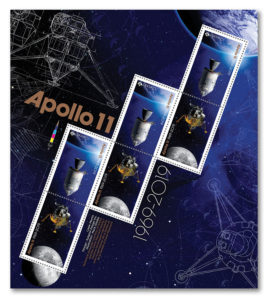
Stamp value: PermanentTM (domestic rate); Issue date: June 27, 2019;
Stamp designer: Subplot Design Inc.; Dimennsions: 30 mm x 45 mm;
Quantity products: 240,000.
Helping make the historic moment possible were many Canadians who worked on the Apollo program. NASA engineers James Chamberlin and Owen Maynard, who are featured on the booklet, played key planning and design roles for Apollo 11. Employees at Héroux Machine Parts Limited (now Héroux-Devtek) in Longueuil, Quebec, manufactured the landing gear legs for the lunar module. The legs remain on the moon at Apollo 11’s landing site in the Sea of Tranquility.

Bears: PermanentTM Domestic stamps
www.canadapost.ca
Share your love of bears with this booklet of 8 PermanentTM domestic stamps featuring stunning, portrait-style photographs of the bears that inhabit Canada’s wilderness. Two of the featured bears, the American black bear and the Kermode bear, are the same species, Ursus americanus. The two remaining stamps depict the grizzly bear (Ursus arctos –also featured on the front of the booklet) and the polar bear (Ursus maritimus), one of the largest bears in the world. Black bears are found in every province and territory except Prince Edward Island. Carrying a recessive gene that sometimes produces a white-colour phase, Kermode bears are a specific population of black bears found on Canada’s west coast. The white-coloured Kermode bear is revered by the Tsimshian First Nations.

Stamp Value: PermanentTM (domestic rate); Issue date: July 24, 2019;
Quantity products: 250,000; Dimennsions: 36 mm x 36 mm;
Stamp designer: Andrew Perro.
Black Bear … The most widely distributed bear species in North America, the American black bear inhabits every province and territory, except Prince Edward Island, where it once lived. Widely hunted while at the same time losing parts of its natural habitat, bears on Prince Edward Island were used in products such as “bear meat” and “bear grease,” which was popular in Europe before the early 20th century as a sort of cure-all treatment for a far-ranging list of ailments, including rheumatism, arthritis and hair loss. Today, the black bear is found in a variety of habitats but “prefers heavily wooded areas and dense bushland,” according to the Canadian Wildlife Federation website. “Maximum numbers probably occur in areas of mixed coniferous-deciduous forests, where human presence is low.” Named after their most common colour, black bears can also sport coats of blond, brown, blue and other shades.
A Kermode named “Warrior” … The stamps’ designs are based on photos by renowned wildlife photographers Robert Postma and Michelle Valberg. Valberg’s images are used on three of the stamps, including one featuring a female Kermode bear named “Warrior” for the scar that gouges her nose just below her eyes. “Warrior walks around like she owns the forest,” said Valberg. “There’s a regal elegance about her stride that’s incredible to watch.” Also known as the spirit bear, particularly in British Columbia, the Kermode bear has white or cream-coloured fur and has long been featured in the oral traditions of coastal First Nations people. It’s the first time a Kermode has been featured on a Canadian stamp, according to Canada Post Stamp Design Manager Jim Phillips, who added this issue focuses on “the beauty of the bear” while respecting its inherently wild nature.

Grizzly Bear … “You need to be open to serendipitous moments,” said Postma, whose photograph of a grizzly mother graces one of the four stamps, adding it takes patience and determination – plus a little bit of luck – to get the right shot. Assessed as being of special concern by the Committee on the Status of Endangered Wildlife in Canada (COSEWIC), the powerful grizzly bear is the second-largest land carnivore in North America and relies primarily on vegetation for food. Once common on the prairies, grizzlies are now found only in the western and northern regions of Canada. Its range around the world, including in the U.S., has shrunk as cities grow and people occupy the bear’s former habitat.
Polar Bear … Polar bears, with two-thirds of the world’s population roaming Canada’s circumpolar region, are also losing their natural habitat. On average, they are the largest bear species in the world – males can weigh up to 800 kilograms – and are well-adapted to life on the sea ice; however, with their hunt of ringed seals dependant on sea ice, polar bears are especially vulnerable to climate change. In fact, they’ve been assessed as a special concern by COSEWIC as a result of the increase in ice loss. Printed by Lowe-Martin using four-colour lithography, the new issue is available in booklets of eight stamps (250,000 printed); panes of four stamps (40,000 printed); and uncut press sheets of 24 stamps (1,500 printed). A total of 7,000 official first-day covers were also serviced with a Klemtu, B.C. cancellation.
Celebrate the beauty of Canada’s bears with this Official First Day Cover. A great gift for animal enthusiasts of all ages, this stylish collectible features the four PermanentTM domestic stamps from our Bears issue. The stamps are postmarked in Klemtu, British Columbia, home to members of the Tsimshian First Nations. A pictorial cancellation depicts a set of paw prints. The collectible envelope has a striking photograph of a polar bear taking a solitary stroll across an Arctic landscape.


2019 … $20 Pure Silver Coin – Second World War:
Battlefront Series – The Normandy Campaign
www.canadapost.ca www.mint.ca
1944: The sound of victory in Normandy… After Juno Beach, there was Buron. Autie. Carpiquet. Caen. Falaise. Steeled by combat experience, the wary soldier from our 2019 Proof Dollar is the image of steady resolve on this 1 oz. piece that commemorates the 75thanniversary of the Normandy Campaign. A salute to the Canadians who soldiered on, this 1 oz. pure silver commemorates the 75th anniversary of the Normandy Campaign (June 6-August 30, 1944).

Face value 20 dollars … Composition: 99.99% Pure Silver;
Mintage:7,500; Finish: Proof; Weight: 31.39 g;
Diameter: 38 mm; Artist: Brad Anderson.
The infantry soldier’s story began on the 2019 Proof Dollar and it continues on this coin’s reverse. It is part of a yearlong journey of remembrance that concludes with an ultra-high relief coin. The sound of victory. Since D-Day marked the start of the Normandy Campaign and the Liberation of Western Europe, the air is filled with sound waves that represent “V” for “Victory” in Morse code. Historical obverse. Just like previous Second World War coins, the obverse features the period-appropriate effigy of King George VI. Part of a continuing series. This is the seventh coin in the Second World War: Battlefront Series.

2019 … $30 Pure Silver Coin – Birds in the Backyard
www.canadapost.ca www.mint.ca
A special gathering of our colourful friends. A backyard feeder or birdhouse is our way of putting out the welcome mat for our winged friends! Bird watching is one of the easiest ways to observe Canada’s wildlife. By attracting birds to our outdoor spaces, we can learn more about our avian neighbours — from their colour variations or their different calls. This simple viewing activity can provide hours of enjoyment, and every visit is a treasured moment.

Face value 30 dollars … Composition: 99.99% Pure Silver;
Mintage:3,000; Finish: Proof with colour; Weight: 62.69 g;
Diameter: 50 mm; Artist: Neil Hamelin.
Step into our backyard. The design is an unusual opportunity to view four different bird species in one image—the blue jay, the downy woodpecker, the northern cardinal and the purple martin. Selective colour highlights the colourful feathers that make these birds a favourite of birdwatchers 2 oz. pure silver. The 50-millimetre diameter allows for more engraved details and a more complex design. A popular theme. Our bird coins are always popular among collectors! While previous coins tend to highlight one species at a time, this beautiful piece brings together four different Canadian bird species in one viewing.

2019 … $5 Pure Silver Coin – This is Canada!
www.canadapost.ca www.mint.ca
Think you know Canada? … Canadians have always been curious about the world and our place in it. The proof: our national passion for trivia. From books to quizzes, and even a best-selling board game, we love fun facts about all things unique — and Canada is home to so many of them. This glow-in-the-dark coin is a show of pride for our countless wonders and amazing feats. On the reverse, Canada’s flag is brought to life by a mix of red colour and a special finish to make the coin’s silver surface appear white. Glow-in-the-dark technology makes this a standout piece, even in the dark, but the fact-filled folder makes it the perfect collectible for any trivia buff.
Celebrate all things Canadian! Show your pride and your knowledge of Canada with this glow-in-the-dark coin. Featuring the colours of Canada. The flag’s red colour makes it stand out. But instead of a white colour application, we used a special finishing technique on the coin’s silver surface to give it a white appearance without the extra layer. Fun from start to finish. Packaged in a folder filled with fascinating facts, this collectible is the perfect souvenir of Canada or a great gift for trivia fans.

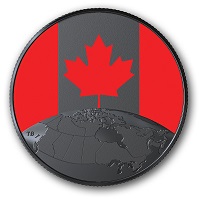
Face value 5 dollars … Composition: 99.99% Pure Silver;
Mintage:100,000; Finish: Specimen with colour; Weight: 7.96 g;
Diameter: 27 mm; Artist: Tony Bianco.
Our latest glow-in-the-dark coin is a fun way to discover some of the many things that make Canada special. Its gift-worthy packaging is filled with facts for trivia buffs, from weather records to unusual place names. While the flag’s red elements glow in the dark, its white square is actually 99.99% fine silver—we used a special finishing technique to give it that near-white appearance.
Design: Designed by Tony Bianco, your coin features the flag of Canada rising up behind an engraved map of the 13 Canadian provinces and territories. When the design is viewed in the dark, the activated photo-luminescent (glow-in-the-dark) technology transforms the flag into a glowing symbol of national pride. The obverse features the effigy of Her Majesty Queen Elizabeth II by Susanna Blunt. Did you know… In Canada, you will find: * More lake area than in any other country. * The largest population of polar bears. * 71% of the world’s maple syrup.


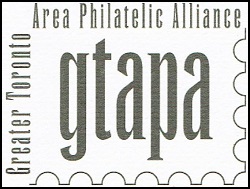
www.gtapa.org
The GTAPA is committed to promote and stimulate the art of philately
to all ages for fun, culture, education, and friendship.


